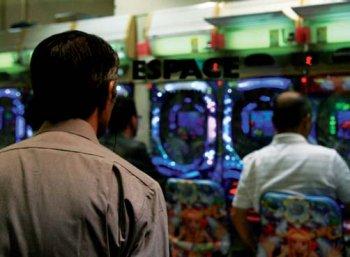Urban Developments: Pachinko Prince
 By Brett Bull
By Brett Bull
Despite the hit that it has taken in recent years, pachinko remains big business for those who find their niche.
A stroll around Shinjuku Station will reveal plenty of pachinko parlors emitting noises of rapidly firing steel balls to the sound of pounding dance tunes.
Such clamor is music to the ears of Ei Yoshida, president of G&E Business School—a pachinko academy to learn all there is to know about what is basically an upright pinball game.
“Our students either want to change their career,” says Yoshida from his third floor office on Shinjuku-dori Avenue, “or they are already working in pachinko and need to learn more.”
Established in 2006, G&E Business School annually instructs 200 students, aged between 19 and 25, to work in this massive industry. Although it has recently been facing a downturn, the industry still remains highly dynamic.
 Pachinko vendors are cleaning up their act to appeal to a different kind of clientele.
Pachinko vendors are cleaning up their act to appeal to a different kind of clientele.
Classes include such subjects as programming of the machines, selecting background animations, marketing and management. Live machines in rows make the classroom look like a real parlor.
“When the students are finished here,” Yoshida says, “they go on to work at companies that produce the machines or in pachinko advertising.” The G&E brochure shows photos of graduates who have moved on to such heavyweight machine manufacturers such as Sankyo and Sammy. The president who, two decades ago, worked as a low-level employee at a parlor, sees pachinko as a business that is very unique to Japan’s landscape.
“As long as the site is 50 meters away from a school or hospital,” he says, “a parlor can be established anywhere.”
To play is easy. Players turn the machine’s dial to launch dozens of balls upward. The silver spheres then tumble downward through mazes of nails and into certain slots or gates that can yield many more balls. The machines are set at one of six cycles, each of which generates a different rate of payout.
Patrons cannot convert the balls to currency inside the parlor. (Only electronics, toiletries, and other small items are available for exchange.) Obtaining cash is done via a middleman at a satellite office away from the parlor. This extra step, by law, makes this form of gambling—a word Yoshida does not prefer—technically legal.
The origins of pachinko probably date back to a horizontal board game imported by an Osaka company from the United States in 1924. In 1948, the first parlor opened in Nagoya following the enactment of the Entertainment Establishments Control Law, under which the game was classified as a form of amusement rather than gambling.
The industry employs 300,000 people at its 14,000 parlors and in 2006, generated 25 trillion yen in turnover. This figure eclipses those of the lotteries, boat racing, horse racing, and other types of gambling combined. Maruhan, Japan’s largest hall operator which also dabbles in bowling and food services, collected revenues of 1.8 trillion yen for the term ending March 31, 2008. Last year, Forbes included two pachinko company presidents, Kunio Busujima of Sankyo and Han Chang-Woo of Maruhan, in their list of “Japan’s 40 Richest.”
While the industry is a sizeable force, overall revenue is down from its peak of 30 trillion yen in 1995. Yoshida, however, does not foresee a problem. “Before, without making much effort,” he says, “a parlor could make money. But now, a person not making any effort is losing business. It’s the basics of capitalism. There is a lot of competition.”
Along these lines, the industry is attempting to rid itself of the seedy, gang-ridden reputation it has acquired over the years and woo women into its halls by providing a clean and pleasant environment. Brand-name goods are increasingly being offered as prizes, and the romantic Korean drama “Fuyu no Sonata,” a large hit with Japanese women, has had its characters appear as background images on numerous machines by maker Kyoraku in recent months.
Yoshida hopes to soon expand his school to include branches in the cities of Nagoya and Osaka. “When I started in pachinko,” he says, “people thought I was entering the world of gangsters. But this is now a legitimate business.” JI
Brett Bull is the editor in chief of the online magazine The Tokyo Reporter
www.tokyoreporter.com. He can be reached at captain@bigempire.com
PHOTOGRAPHY: Sarah Noorbakhsh





